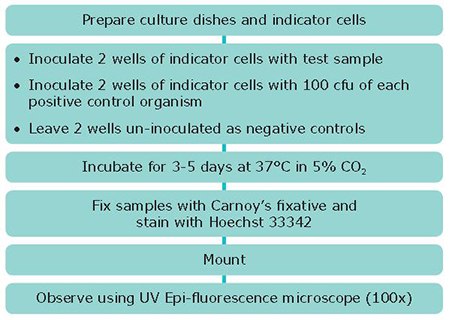Cell Culture Protocol 10: Testing Cells for Mycoplasma Contamination by Hoechst DNA Staining
ECACC Laboratory Handbook 4th Edition
Aim

DNA staining methods such as indirect Hoechst staining techniques are quick with results available within 72 hours which compares favorably with 4 weeks for mycoplasma detection by culture isolation. Staining of cell lines directly with a DNA stain can provide results in 24 hours, however, in a much-reduced sensitivity (~106 cfu/mL). This may be improved by co-culturing the test cell line in the presence of an indicator cell line such as Vero. This enrichment step results in a sensitivity of 100 cfu/mL of culture and is the preferred method used by ECACC. This step also improves sensitivity by increasing the surface area upon which mycoplasma can adhere. As with detection by culture, DNA staining methods are suitable for the detection of mycoplasma from cell cultures or cell culture reagents.
Materials
- Cell Culture Media: pre-warmed to the appropriate temperature (refer to the ECACC cell line data sheet for the correct medium and temperature.)
- Methanol (322415)
- Acetic Acid Glacial (A6283)
- Hoechst 33342 stain solution (B2261)
- Indicator cells e.g. Vero cells (84113001)
- Mycoplasma hyorhinis NCTC10130 and
- Mycoplasma orale NCTC 10112
Equipment
- Personal protective equipment (sterile gloves, laboratory coat, safety visor)
- Waterbath set to 37 °C
- Microbiological safety cabinet of appropriate containment level
- CO2 Incubator set at 37 °C
- Microscope (UV Epi-Fluorescence.)
- Tissue culture dishes
- Multi-dish 12 well
- Microscope slides and 13mm coverslips
- Aluminum foil
Procedure

- Place sterile coverslips in tissue culture dishes/plates e.g. 12 well plates.
- Inoculate 2mL of indicator cells into the prepared dishes e.g. 2 x 104 Vero cells per well of 12 well plate.
- Incubate at 37 °C in 5% CO2 for 2-24 hrs to allow the cells to adhere to the cover slips.
- Bring attached test cell lines into suspension using a cell scraper. Suspension cell lines may be tested directly.
- Remove 1mL of culture supernatant from duplicate wells and add 1mL of test sample to each. Inoculate 2 wells with 100 cfu of each positive control organism.
- Leave duplicate tissue culture wells un-inoculated as negative controls.
- Incubate dishes at 37 °C in 5% CO2 for 3-5 days.
- After 3-5 days fix cells to cover-slip by adding a minimum of 2 mL of freshly prepared Carnoy’s fixative (1:3 glacial acetic acid: absolute methanol) to each dish and leave for 3 minutes. Then decant to toxic waste bottle. Repeat once more. Add a minimum of 2mL Hoechst stain 0.4μg/nl. Leave for 3 minutes shielded from direct light e.g. by covering with aluminum foil.
- Decant used and unused stain to toxic waste.
- Add 1 drop of mountant to a pre-labelled microscope slide and place coverslip (cell side down) onto slide.
- Keep slide covered with aluminum foil, allowing it to set for at least 15 minutes at 37 °C or for 30 minutes at room temperature.
- Observe slide under UV Epi-Fluorescence at 100x.
Criteria for a Valid Result
Negative controls show no evidence of mycoplasma infection; Positive controls show evidence of mycoplasma infection; Vero cells clearly seen as fluorescing nuclei.
Criteria for a Positive Result
Samples infected with mycoplasma are seen as fluorescing nuclei plus extra-nuclear fluorescence of mycoplasma DNA (small cocci or filaments).
Criteria for a Negative Result
Uninfected samples are seen as fluorescing nuclei against a dark background. There should be no evidence of mycoplasma i.e. extra-nuclear fluorescence of mycoplasma DNA.
Notes
- DNA stains such as Hoechst stain bind specifically to DNA. In all cultures cell nuclei will fluoresce. In theory uncontaminated cultures will show only fluorescent nuclei whereas mycoplasma positive cultures contain small cocci or filaments which may or may not be adsorbed onto the cells (Figure 11). However, please note that any extraneous DNA will also fluoresce e.g. cell debris - which is sometimes mistaken for mycoplasma contamination.
- Hoechst stain is toxic and should be handled and discarded with care.
- In some instances results may be difficult to interpret for the following reasons:
• Bacterial/yeast/fungal contamination
• Too much debris in the background (as in the case of hybridoma cell lines)
• Broken nuclei as cells are all dead
• Too few or no live cells - Although this procedure recommends the use of positive controls, this may not necessarily be feasible or desirable in a cell culture facility with limited resources. If positive controls are to be used they should be done so in a separate laboratory from the main tissue culture facility. If positive controls are not being used then it is strongly recommended that you get an independent testing laboratory to periodically test your cell lines.
- ECACC recommends that samples are tested for mycoplasma using at least two detection methods (e.g. indirect DNA stain and culture isolation) for a more reliable result. This is due to the varying detection sensitivities of the methods for different species of mycoplasma.
ECACC offers a mycoplasma testing service where three different methods of detection are available i.e. PCR, indirect DNA stain and culture isolation.
To continue reading please sign in or create an account.
Don't Have An Account?